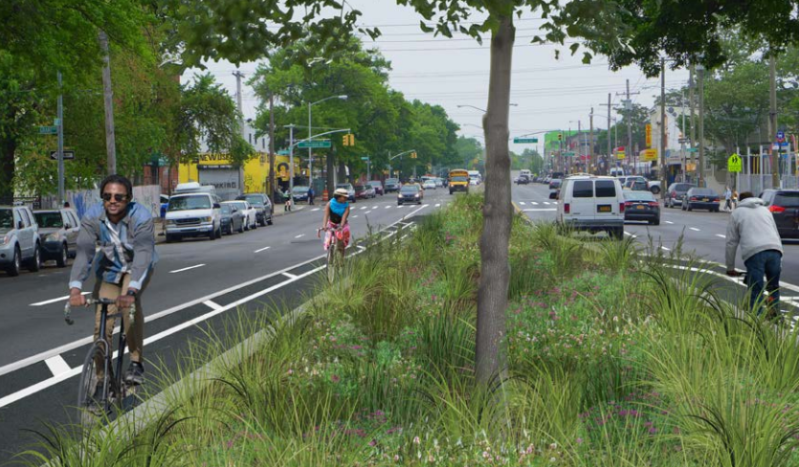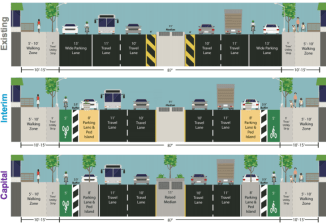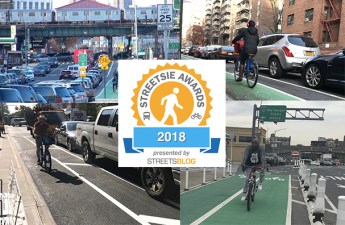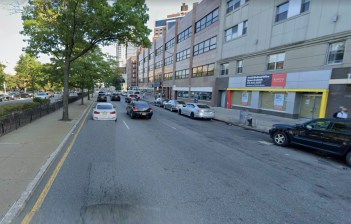DOT Plans Median Bike Lanes on Eastern Section of Atlantic Avenue

Raised median bike lanes are slated for a stretch of Atlantic Avenue crossing the Brooklyn-Queens border, in a project NYC DOT presented last week to Queens Community Board 9 [PDF].
Atlantic Avenue is one of four major streets slated for design overhauls in the de Blasio administration’s $250 million “Vision Zero Great Streets” initiative. The project is proceeding in phases on different sections of Atlantic, which extends more than ten miles from end to end.
The first phase, between Georgia Avenue and Conduit Boulevard, which broke ground last year, did not impress. It maintained three motor vehicle lanes in both directions, adding left turn bays and expanding existing medians further into intersections.
In a 2016 report [PDF], Transportation Alternatives said the project would make only a “marginal impact,” noting that the “interventions are designed to protect pedestrians from dangerous drivers, instead of implementing changes that would fundamentally alter dangerous driving behavior, such as protected bike lanes, widened sidewalks and medians, decreased traffic lane width and other complete street innovations.”
Phase two covers the mile between Conduit Boulevard and Rockaway Boulevard. Since 2010, five people have been killed and 34 severely injured in traffic crashes on these blocks. More than 600 other people, mostly car occupants, suffered less severe injuries.
DOT’s design is a step up and includes some of the features TransAlt called for. The biggest difference: DOT is replacing the central car lanes with raised bike lanes. The layout is similar to Allen Street in Manhattan, though the median is not as wide:

Like the first phase, this project will expand medians to protect pedestrians in crosswalks, and left turn lanes will be added at eight intersections. Left turns will be banned at Eldert Lane. DOT is also studying a new signalized crossing at Lincoln Avenue and Grant Avenue, as well as ways to improve pedestrian access across Atlantic Avenue near City Line Park.
Council Member Rafael Espinal, who represents the Brooklyn side of the project area, supports the redesign.
DOT presented the project to Queens Community Board 9 last week. Some members couldn’t imagine Atlantic Avenue with bike lanes, according to the Queens Chronicle. “It’s a great idea but I don’t think it’s a good idea to put it there. It’s too dangerous,” board member Maharani Singh said.
The redesign will clearly make it safer to bike on a street that’s currently too intimidating for most people to give it a try, and this design could set an important precedent for other sections of Atlantic Avenue. But the lack of any physical barriers in the city’s rendering looks like a weakness. Raised bike lanes with mountable curbs are still vulnerable to motorist incursions.
The city is moving forward with the project, according to the Chronicle, with construction slated to begin in late 2019.


